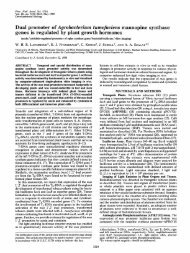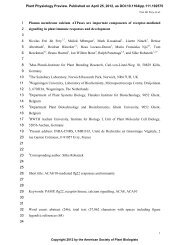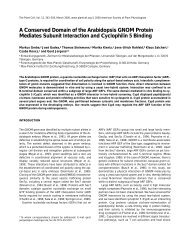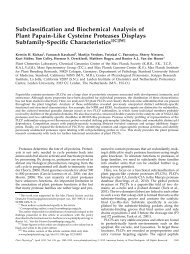1 Transposon and T-DNA mutagenesis
1 Transposon and T-DNA mutagenesis
1 Transposon and T-DNA mutagenesis
You also want an ePaper? Increase the reach of your titles
YUMPU automatically turns print PDFs into web optimized ePapers that Google loves.
Protocol 3. Continued<br />
3. Use 10 +I for self-ligation in 400 pI volume (2.5 U T4 <strong>DNA</strong> ligase, 14"C,<br />
overnight).<br />
4. Add 2 yl of carrier tRNA (10 mglml) <strong>and</strong> 40 pI of 3 M NaAc pH 5.5.<br />
Phenol:chloroform extract <strong>and</strong> precipitate the <strong>DNA</strong> by adding 1 ml of<br />
cold 100% (vlv) ethanol to the supernatant, at -70°C for at least<br />
30 min.<br />
5. Centrifuge the <strong>DNA</strong> (10 min). Wash the pellets with 500 pl of 70% (vlv)<br />
ethanol, dry, <strong>and</strong> resuspend in 10 p1 H,O. Compare a 2 p1 aliquot with<br />
a sample of digested, but unligated <strong>DNA</strong> by electrophoresis. Estimate<br />
<strong>DNA</strong> concentration by fluorimetry or A,,dA,,,.<br />
C. IPCR for Ds elements<br />
1. Use 5 p1 (50 ng) of <strong>DNA</strong> template in a 100 p1 PCR reaction mix,<br />
containing 1 X PCR buffer, 5 pI of each first set primer (20 pM), 8 pI of<br />
2.5 mM dNTP mix, <strong>and</strong> 2.5 U Taq <strong>DNA</strong> polymerase.<br />
2. PCR reaction:<br />
(a) 5 min 94°C.<br />
(b) 35 cycles of 30 sec 94°C 30 sec 55"C, <strong>and</strong> 3 min 72°C.<br />
3. Use 5 pI for a further PCR reaction with a second set of primers, using<br />
conditions as in step 2.<br />
4. Check 10 pI on a 2% (wlv) agarose minigel.<br />
D. Cloning of IPCR fragments for Ds elements<br />
1. Size separate IPCR fragments on a 1.2% (wlv) TBE-agarose gel. Cut<br />
out the <strong>DNA</strong> b<strong>and</strong>s from the gel, elute, <strong>and</strong> clone in an appropriate<br />
PCR cloning vector (53).<br />
2.5 Further applications of transposon tagging<br />
2.5.1 Promoter or enhancer trapping with transposable<br />
elements<br />
Less than 4% of Ds insertions were found to yield a visible mutant phenotype<br />
in Arabidopsis (25, 26). To benefit from the other 96%, transposons can be<br />
equipped with a reporter gene that is activated when the transposon is<br />
integrated in the vicinity of a transcriptional regulatory region, such as a<br />
promoter or enhancer sequence. In Drosophila melanogaster, P-elements<br />
containing a promoterless lac2 gene fused to the weak P-element transposase<br />
promoter are successfully used to detect transcribed genomic regions by<br />
transposon insertions (40). In Nicotiana <strong>and</strong> Arabidopsis this technique was<br />
F<br />
1 first exploited using T-<strong>DNA</strong> insertions carrying promoterless reporter genes<br />
fused to the right T-<strong>DNA</strong> border (414, <strong>and</strong> discussed later).<br />
[ Fedoroff <strong>and</strong> Smith (21) demonstrated the use of an Ac-Ds based promoter<br />
1 <strong>and</strong> enhancer trapping system in Arabidopsk. They constructed Ds elements<br />
I<br />
which carried a promoterless uidA gene, linked either to a minimal promoter<br />
t (the 46 to +6 region of the CaMV 35s core promoter) or directly to the 5'<br />
I terminus of Ds. Combination of a Ds-uidA element with a CaMV 35s-Ac<br />
transposase source in plants resulted in P-glucuronidase (GUS) expressing<br />
sectors after transposition. Recently a similar, but more advanced enhancer<br />
<strong>and</strong> gene trapping system has been described, in which plants are selected<br />
with Ds elements transposed to loci unlinked to the T-<strong>DNA</strong> donor locus<br />
1 (45,46). Currently populations of plants containing independent transpositions<br />
are being built up to assay for GUS expression.<br />
I 2.5.2 Insertion trapping by PCR<br />
, A novel technique, which may be widely used in Arabidopsis, exploits the<br />
abundance of transposons for identification of insertions in specific genes.<br />
/ Originally developed for Drosophila melanogasfer (47) this PCR-based<br />
approach was taken to screen a library of P-elements in a fly-population using<br />
/ two primers, one specific for terminal sequence of the P-element, the other<br />
derived from a target gene in which P-element insertions are desired. The<br />
resolution of PCR screening in Drosophila permitted the detection of one<br />
individual with the right insert in a population of 1000 flies. Analogously, with<br />
, the aid of the Tcl transposon in Caenorhabditis elegans, Zwaal et al. (48) have<br />
found 23 inserts for 16 different genes in a library of 960 worm cultures,<br />
pooled in a 10 X 10 X 10 three-dimensional matrix of 30 pools.<br />
In plants this system has been applied to isolate mutants from Petunia<br />
hybrida using the dTphl transposon (49,76) <strong>and</strong> recently also in Arabidopsis<br />
using populations of plants containing T-<strong>DNA</strong> (50) or En-I transposable<br />
element inserts (82,83). A prerequisite for this type of insertion-trapping, is a<br />
very high frequency of independent transpositions. For r<strong>and</strong>om inserts in<br />
Arabidopsis, only En-I systems seem to approach such high frequencies.<br />
Currently three such populations have been constructed. At the MPI fur<br />
Zuchtungsforschung, the AMAZE population of 8000 lines carrying 48000<br />
5 independent En insertions has been generated (83). At CPRO-DL0 a<br />
: population of 5000 plants carrying 45000 independent I element insertions has<br />
<br />
been prepared (Speulman et al., in prep.) <strong>and</strong> at the Sainsbury lab of the John<br />
Innes Institute the SLAT population of about 48000 lines has been grown in<br />
. pools of 50, of which approximately 80% carry independent insertion events<br />
(84). Assuming a r<strong>and</strong>om distribution of inserts, the combined populations<br />
will on average contain an insert every 1 kb. With these transposon mutagenized<br />
populations it will not only be possible to obtain mutants for previously<br />
isolated genes by reverse genetics, but also to analyse mutations<br />
displaying very subtle phenotypes.






